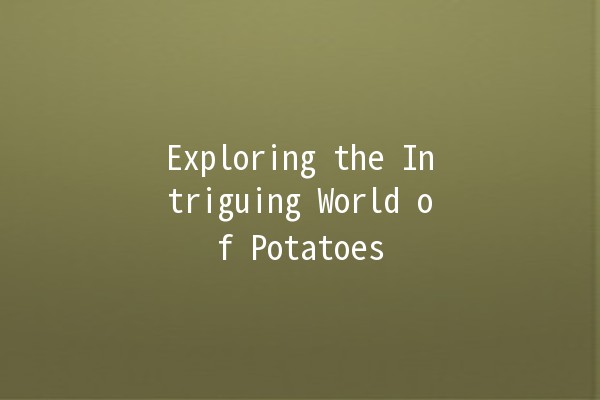Understanding Potatoes: A Brief Overview
Potatoes, originating from the Andes mountains of South America, have become a staple food for many cultures worldwide. They are not just versatile in cooking but also packed with nutritional benefits. This article aims to answer common questions related to potatoes, provide practical tips for preparing and cooking them, and explore their various uses in our daily lives, all while ensuring you're equipped with productivityenhancing strategies.
Nutritional Benefits of Potatoes
Potatoes are rich in several essential nutrients, including:
Vitamin C: Important for maintaining the immune system.
Potassium: Supports heart health and muscle function.
Dietary Fiber: Aids in digestion and promotes satiety.

B Vitamins: Essential for energy metabolism.
Incorporating potatoes into your diet can yield numerous health benefits while offering a comforting addition to various meals.
Smart Tips for Cooking Potatoes
Different potatoes have varied starch contents that lend themselves better to specific cooking methods.
Waxy Potatoes (e.g., Red or New Potatoes): Best for boiling, roasting, or preparing salads due to their smooth texture.
Starchy Potatoes (e.g., Russet): Ideal for baking, frying, and mashing, giving a fluffy texture.
Example: Use Russet potatoes for a classic mashed potato recipe, ensuring a creamy consistency.
When preparing potatoes, cutting them into uniform sizes ensures even cooking.
Tip: Use a mandoline slicer for consistent thickness, especially for dishes like scalloped potatoes.
Application: When making potato gratin, uniform slices allow for even heat distribution and ensure a perfect bake.
Potatoes are incredibly versatile and can be prepared in numerous ways.
Boiling: Softens potatoes for salads or purees.
Baking: Gives a crispy skin while maintaining a tender interior.
Frying: Ideal for achieving a crunchy texture, making homemade fries or chips.
Example: Try a mix of boiling and frying for a crispy potato scone. Boil first for softness, then panfry for a golden exterior.
Potatoes can absorb flavors exceptionally well, making them perfect for seasoning.
Herbs: Fresh herbs like rosemary and thyme elevate baked potatoes.
Spices: Paprika or garlic powder can enhance roasted varieties.
Practical Tip: Before baking, toss your potato wedges in olive oil, garlic powder, and fresh rosemary for a flavorful twist.
Proper storage prolongs the shelf life and quality of your potatoes.
Keep in a Cool, Dark Place: Avoid exposure to sunlight to prevent sprouting.
Avoid Refrigeration: Cold temperatures can convert starch to sugar, altering taste and texture.
Implementation: Store potatoes in a burlap sack or a cardboard box to optimize airflow and minimize moisture retention.
Frequently Asked Questions
Potatoes turn green due to exposure to light, which causes the production of chlorophyll and solanine, a toxic compound. While a small amount of green is usually harmless if cooked properly, it's best to avoid eating green potatoes as they can cause nausea and other digestive issues. Always peel off any green parts before cooking.
Potatoes that have spoiled will typically exhibit signs such as a soft texture, dark spots, and unpleasant odors. You may also notice sprouting. While minor sprouting can be trimmed away, if the potato is soft or has a strong smell, it's best to discard it.
Yes, potato peels are nutritious and contain fiber and other beneficial compounds. However, it’s advisable to wash potatoes thoroughly to remove dirt and pesticides. If you enjoy consuming the skin, consider using organic potatoes to minimize exposure to chemicals.
Potatoes can be used in various innovative recipes, such as:
Potato Pancakes (Latkes): Grated potatoes fried until golden, served with applesauce or sour cream.
Loaded Potato Skins: Baked potato skins filled with cheese, bacon bits, and chives.
Potato Gnocchi: Soft dumplings made from potato, often served with tomato sauce or pesto.
To avoid gluey mashed potatoes, use starchy varieties like Russet. After boiling, let them steam dry for a few minutes before mashing. Avoid overmixing, as this can release excess starch and lead to a gummy texture.
Leftover potatoes can be repurposed into several dishes:
Potato Salad: Combine with mayo, mustard, and veggies for a fresh salad.
Frittata: Mix with eggs and any leftover vegetables for a hearty breakfast.
Hash: Sauté with onions, peppers, and spices for a delicious hash.
From their nutritional benefits to their versatility in the kitchen, potatoes offer an abundance of opportunities for creativity in cooking. By understanding the best practices for selection, preparation, and storage, you can maximize your potato dishes and minimize waste. Engage with this wonderful ingredient, and let your culinary skills shine!